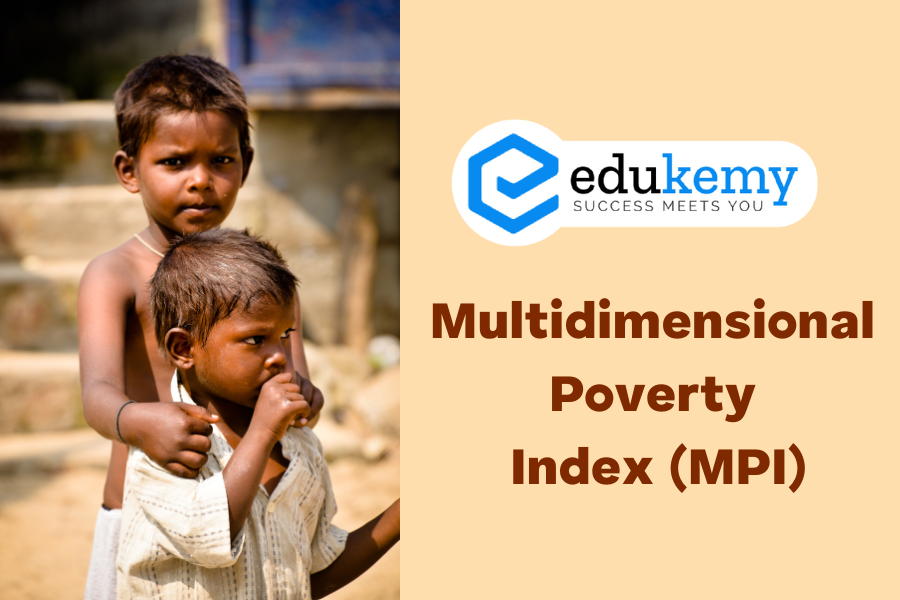
The Multidimensional Poverty Index (MPI) is a comprehensive measure of poverty that goes beyond income-based criteria. Developed in 2010 by the Oxford Poverty and Human Development Initiative (OPHI) in collaboration with the United Nations Development Programme (UNDP), MPI incorporates multiple dimensions to provide a more holistic understanding of poverty. It replaced the previous Human Poverty Index and offers a nuanced approach to capturing the various aspects of deprivation. The index uses three key dimensions: health, education, and standard of living, each measured by specific indicators.
Contents
Dimensions and Indicators:
- Health:
- Child Mortality
- Nutrition
- Education:
- Years of Schooling
- Children Enrolled
- Standard of Living (Living Standards):
- Cooking Fuel
- Toilet
- Water
- Electricity
- Floor
- Assets:
- Additional indicators related to assets and living standards.
Weighting:
- Each dimension and indicator within a dimension is given equal weight in the calculation of the MPI.
Calculation:
- The MPI is an index of acute multidimensional poverty, indicating the number of people experiencing poverty across multiple dimensions. A person is considered multidimensionally poor if they suffer deprivations in 33% or more of the weighted indicators.
Significance of MPI:
- Helps in identifying the sources of poverty by highlighting deprivations in specific dimensions.
- Allows governments to target interventions more effectively by addressing the multidimensional nature of poverty.
- Complements income-based measures by considering health, education, and living standards.
Angus Deaton’s Perspective:
- Angus Deaton, a Nobel laureate in economics, emphasizes the importance of both quantity and quality of data for shaping effective public policy. The MPI, by incorporating various dimensions, contributes to a more nuanced understanding of poverty and guides policymakers in designing comprehensive poverty alleviation strategies.
The Multidimensional Poverty Index serves as a valuable tool for policymakers, researchers, and development practitioners in their efforts to tackle poverty from a multidimensional perspective.
UN Development Programme, Multidimensional Poverty Index, and India (2019):
The UN Development Programme (UNDP) and the Oxford Poverty and Human Development Initiative (OPHI) released the global Multidimensional Poverty Index (MPI) in 2019, providing insights into India’s progress in poverty reduction. Key findings from the report include:
- Poverty Reduction in India:
- India lifted 271 million people out of poverty between 2006 and 2016.
- India recorded the fastest reductions in the MPI values during this period.
- Improvements in MPI Values:
- India’s MPI value decreased from 0.283 in 2005-2006 to 0.123 in 2015-2016.
- State-Level Progress:
- Jharkhand in India significantly reduced the incidence of multidimensional poverty from 74.9% in 2005-2006 to 46.5% in 2015-2016.
- Specific Areas of Improvement:
- Deprivation in nutrition reduced from 44.3% in 2005-2006 to 21.2% in 2015-2016.
- Child mortality dropped from 4.5% to 2.2%.
- People deprived of cooking fuel decreased from 52.9% to 26.2%.
- Deprivation in sanitation reduced from 50.4% to 24.6%.
- Those deprived of drinking water decreased from 16.6% to 6.2%.
- More people gained access to electricity, with deprivation reduced from 29.1% to 8.6%.
- Deprivation in housing reduced from 44.9% to 23.6%.
- Assets deprivation decreased from 37.6% to 9.5%.
- Progress Toward SDG 1:
- India’s statistical progress is significant toward achieving Sustainable Development Goal 1, which aims to end poverty in all its forms, everywhere.
- Niti Aayog Task Force on Poverty Elimination (2015):
- Constituted in 2015 under the Chairmanship of Dr. Arvind Panagariya, the Niti Aayog Task Force on Poverty Elimination focused on measuring poverty and proposing strategies to combat it.
- The report emphasized faster poverty reduction through employment-intensive sustained rapid growth and effective implementation of anti-poverty programs.
- The Task Force addressed challenges in estimating poverty but provided recommendations for poverty reduction strategies.
The findings underscore India’s significant strides in reducing multidimensional poverty and aligning with global goals for poverty eradication. The report reflects improvements in various indicators, indicating a positive trajectory in addressing the diverse dimensions of poverty.
FAQs
1. What is the Multidimensional Poverty Index (MPI)?
- The MPI is a measure of acute poverty that identifies multiple deprivations in the lives of individuals. It goes beyond income-based metrics by considering various dimensions such as health, education, and living standards.
2. How is the MPI different from traditional poverty measures?
- Unlike traditional measures that focus solely on income, the MPI looks at various dimensions of poverty simultaneously, providing a more holistic understanding of poverty. It considers factors like access to healthcare, education, sanitation, and living standards, offering a comprehensive picture of deprivation.
3. How is the MPI calculated?
- The MPI is calculated by analyzing a range of indicators within different dimensions of poverty, such as nutrition, child mortality, years of schooling, and access to amenities like clean water and electricity. Individuals are considered multidimensionally poor if they are deprived in at least one-third of the weighted indicators.
4. What are the advantages of using the MPI?
- The MPI offers a more nuanced understanding of poverty by considering multiple dimensions, helping policymakers identify areas of need more accurately. It provides insights into specific deprivations faced by individuals, allowing for targeted interventions to alleviate poverty effectively.
5. How is the MPI used in policy and decision-making?
- Governments, international organizations, and policymakers use the MPI to design and implement poverty reduction strategies. By identifying the most vulnerable populations and the dimensions in which they are deprived, policymakers can tailor interventions to address the specific needs of communities, leading to more impactful poverty alleviation efforts.
In case you still have your doubts, contact us on 9811333901.
For UPSC Prelims Resources, Click here
For Daily Updates and Study Material:
Join our Telegram Channel – Edukemy for IAS
- 1. Learn through Videos – here
- 2. Be Exam Ready by Practicing Daily MCQs – here
- 3. Daily Newsletter – Get all your Current Affairs Covered – here
- 4. Mains Answer Writing Practice – here

